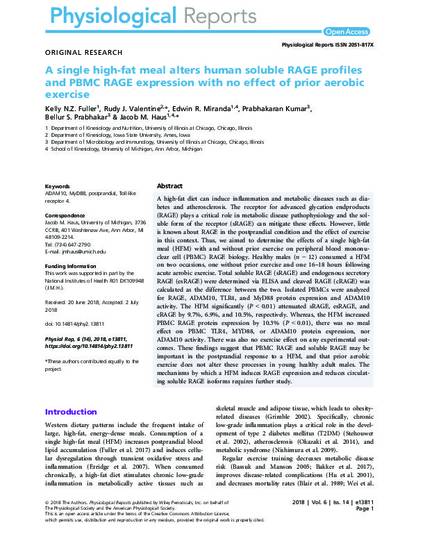
A high‐fat diet can induce inflammation and metabolic diseases such as diabetes and atherosclerosis. The receptor for advanced glycation endproducts (RAGE) plays a critical role in metabolic disease pathophysiology and the soluble form of the receptor (sRAGE) can mitigate these effects. However, little is known about RAGE in the postprandial condition and the effect of exercise in this context. Thus, we aimed to determine the effects of a single high‐fat meal (HFM) with and without prior exercise on peripheral blood mononuclear cell (PBMC) RAGE biology. Healthy males (n = 12) consumed a HFM on two occasions, one without prior exercise and one 16–18 hours following acute aerobic exercise. Total soluble RAGE (sRAGE) and endogenous secretory RAGE (esRAGE) were determined via ELISA and cleaved RAGE (cRAGE) was calculated as the difference between the two. Isolated PBMCs were analyzed for RAGE, ADAM10, TLR4, and MyD88 protein expression and ADAM10 activity. The HFM significantly (P < 0.01) attenuated sRAGE, esRAGE, and cRAGE by 9.7%, 6.9%, and 10.5%, respectively. Whereas, the HFM increased PBMC RAGE protein expression by 10.3% (P < 0.01), there was no meal effect on PBMC TLR4, MYD88, or ADAM10 protein expression, nor ADAM10 activity. There was also no exercise effect on any experimental outcomes. These findings suggest that PBMC RAGE and soluble RAGE may be important in the postprandial response to a HFM, and that prior aerobic exercise does not alter these processes in young healthy adult males. The mechanisms by which a HFM induces RAGE expression and reduces circulating soluble RAGE isoforms requires further study.
Available at: http://works.bepress.com/rudy-valentine/3/
This article is published as Fuller KNZ, Valentine RJ, Miranda ER, Kumar P, Prabhakar BS, Haus JM. A single high-fat meal alters soluble RAGE profiles and PBMC RAGE expression with no effect of prior aerobic exercise. Physiol Rep. 2018; 6(14):e13811. Doi: 10.14814/phy2.13811